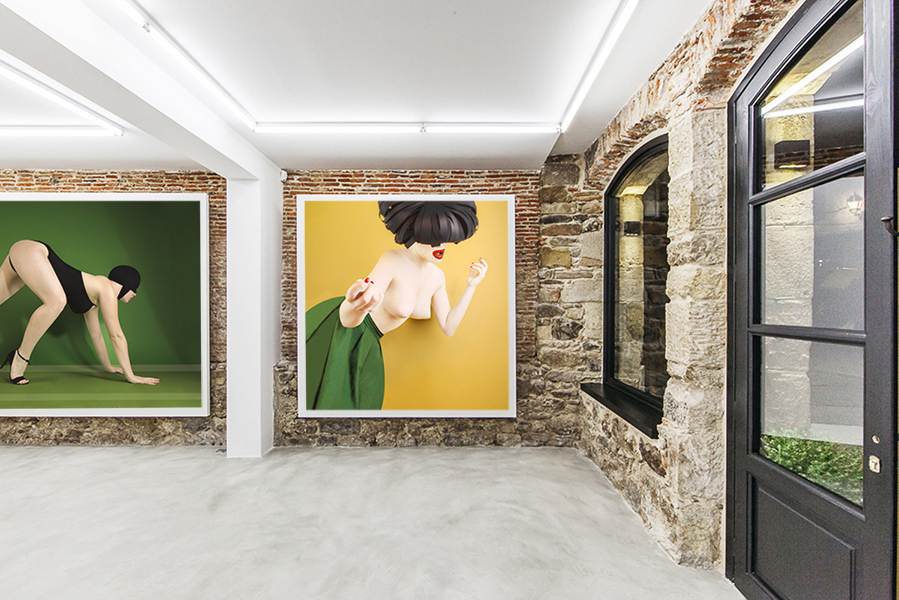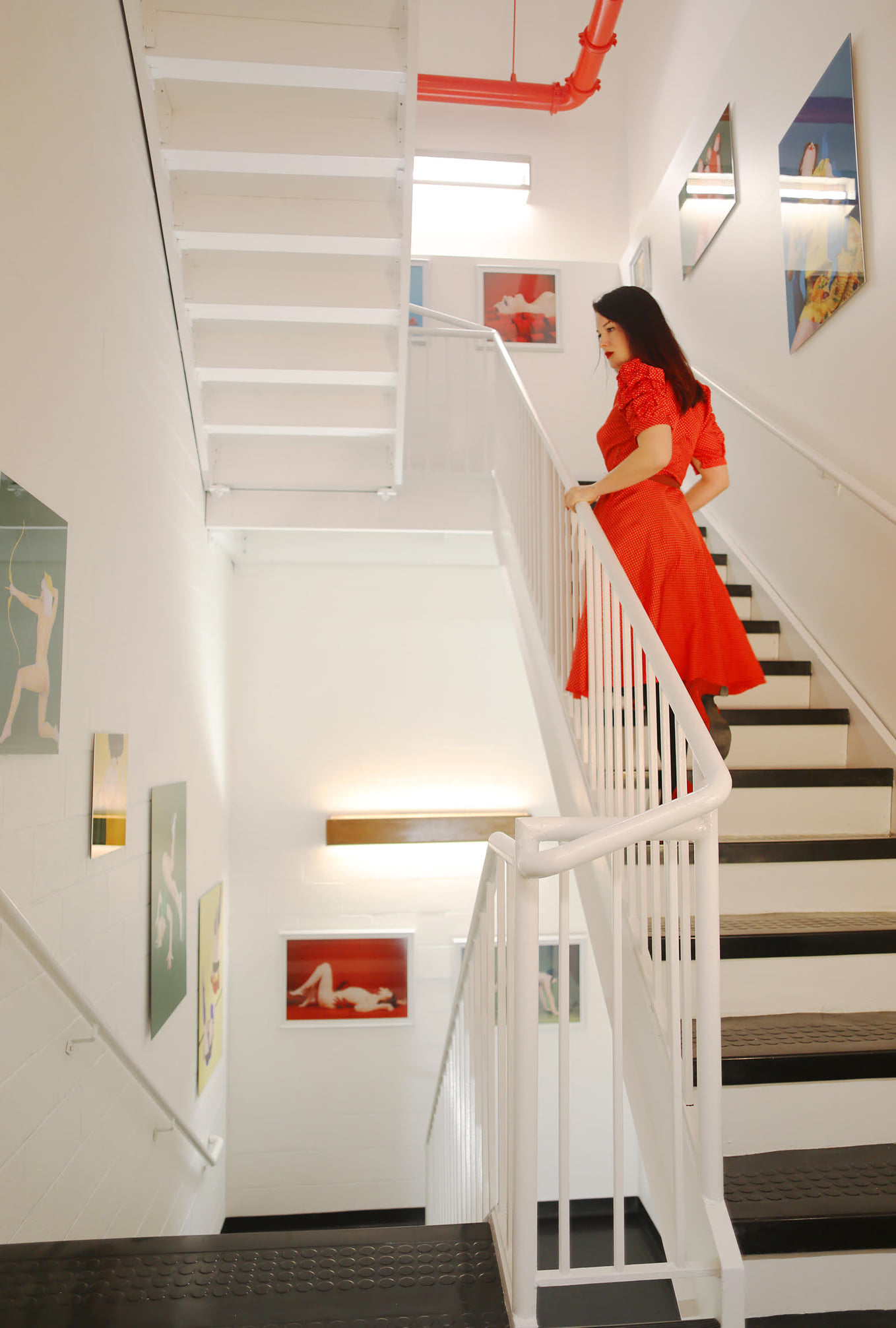Obscurentisme
Democratic Obscurantism in three part
In this work directly inspired by Bosch, Nathalie De Zan intertwines Christian iconography and secular symbols with her own perspective. She observes the dark aspects of an ever-changing world from which she extracts her Garden of Earthly Delights. In his XVI century masterpiece, Jerome Bosh represents an era caught in between a crepuscular gothic Middle-Ages and the Renaissance. The influence of illumination can be found in the work of both Nathalie De zan and Bosch. Illumination was an integral part of Middle Ages aesthetics and disappeared with the rise of the printing press. To explore graphic arts, Nathalie De Zan uses multiple techniques which developed alongside the printing press. She unties herself from photography but never neglects pictorial references. Democratic Obscurantism in Three Stages is arranged in the style of medieval altarpieces. Just like The Garden of Earthly Delights, it does not follow liturgical tradition but is a tryptich. The number three is considered perfect and symbolises the divine. Ends and beginnings meet and the merged trinity becomes One. In her work, Nathalie De Zan does not want to make a theological comment but her approach is not deprived of a sense of irony and humour. One could wonder what the central idol represents. Despite there being a possibility of it representing her own fantasised ideal feminine figure, the title hints at the satirical status of this canon of beauty. Democracy, or the voice given to the people by the State, seems to have become a farce.After all, is she not withdrawing into herself? The triptych admits the hierarchical importance of the central panel although it also follows a chronological order. On the left panel is Marianne, emblem of the French revolution. She can be recognised because she is often depicted as a bust wearing a Phrygian cap. Here, the naked female body is edified where Christianism would have deemed it obscene. A Female-Goddess reigns on the central panel. Here, the female body is adroitly demeaned and equality principles are scorned. This contrasts with a triumphant Marianne exhibiting her bosom in the name of freedom.
The artist shares her doubts regarding the femininity which can be perceived in the deceitfulness of seduction and questions genre in its sociocultural representation.
The artist exposes a paradox to her audience by representing a profane and ironic figure, proof of a fallen humankind, on the central panel which is “invested with supreme sacredness”. An allegory of the New World can be seen on the right panel. Women are displayed like totems and have become the circus freaks of entertainment society. In the end, the central panel reminds the audience of the existing balance between occult and spectacular, from the liberation of the body to a decadence that lets its exploitation define its identity. This piece is a reflection on the representation and development of individualism alongside reproductibility (the history of the printing press is closely linked to the development of humankind and culture). Everyone will choose their god, so may the most seductive one be favoured. This god will impress the masses but eventually be submitted to them. After all, the symbolic system deployed by the artist supports her approach: Human Beings are prisoners of their own vices. Bosch adopted a mode of painting inspired by religion for profane purposes. Similarly, Nathalie De Zan adopts a defying position where the profane triumphed over the sacred but democracy failed to. Thus, the artist shares her doubts regarding the femininity which can be perceived in the deceitfulness of seduction and questions genre in its sociocultural representation.
Translation by Marie Krebs
Obscurantisme Democratique en trois temps
Directement inspirée par l’oeuvre de Bosch, iconographie chrétienne et symbolisme républicain s’entremêlent aux visions insolites de Nathalie De Zan, observant les ténèbres d’un monde en mutation d’où elle extrait son « Jardin des délices ». Jérôme Bosch, et dans cette oeuvre-phare en particulier (Le Jardin des délices datant du début du 16ème siècle), est représentatif de cet entre-deux-époques, du crépusculaire Moyen âge gothique à la Renaissance. On retrouve ici comme dans l’oeuvre du maître une iconographie proche de l’enluminure, art propre à la tradition médiévale et qui disparaîtra avec l’essor de l’imprimerie. Ces techniques multiples que développe cette dernière, Nathalie De Zan les utilise pour explorer les arts graphiques en se détournant de la photographie, sans extraire ses références picturales. À la façon des retables du Moyen-Age et du Jardin des délices, mais comme ce dernier exempt de leur sens liturgique, « Obscurantisme démocratique en trois temps » se déploie en triptyque, le chiffre Trois considéré comme complet, parfait, réunissant début et fin, symbolisant la divinité et une fois fermé devenu Un. Nathalie De Zan s’écarte de tout propos religieux sans pour autant extraire de son point de vue ironie et humour. On peut se demander si cette idole au centre de la composition représente l’idéal féminin fantasmé de l’artiste ou si elle est un canon de beauté qui constitue l’élément principal d’une oeuvre satirique, bien que son titre en donne l’indication. La démocratie, la voix donnée au peuple par l’État semble être devenue farce. Après tout, ses fondements ne la referment-elle pas sur elle-même ? Il s’agit d’une lecture conventionnelle de triptyque. Même si elle admet la position hiérarchique du panneau central, elle se suit chronologiquement. Sur le volet de gauche, on reconnaît l’emblème de la Révolution, Marianne coiffée de son bonnet phrygien, son buste sculpté est l’une des principales formes de sa représentation. Là où dans le christianisme le corps de la femme est perçu comme obscène, il est ici édifié. Ainsi, sur le panneau central siège une déesse-femme. En parallèle à une triomphale Marianne exhibant fièrement sa poitrine au nom de la liberté, le corps de la femme est ici habilement abaissé, bafouant les principes mêmes d’égalité. L’artiste impose au spectateur un hiatus entre la position hiérarchique du panneau central pourtant « investi d’une sacralité suprême » et la représentation d’une scène profane et ironique d’une humanité déchue. Sur le volet de droite, une allégorie du Nouveau Monde où les femmes arborées comme des totems sont devenues les monstres de foire de la société du spectacle.
L’artiste nous fait part de ses doutes quant à la féminité, percevable dans le piège de la séduction, interrogeant le genre dans sa représentation socioculturelle.
Finalement, le panneau central renvoie à un équilibre entre l’occulte et le spectaculaire, de la libération à la décadence du corps réduit à son exploitation. Réflexion sur la représentation et le développement de l’individualisme avec la reproductivité (l’histoire de l’imprimerie étant étroitement liée au développement de l’humanité et de la culture) : Puisque chacun choisira son dieu, on préfèrera le plus séduisant, celui qui impressionnera le plus mais que l’on finira par soumettre à la masse. Au final, le système symbolique que déploie l’artiste a pour but d’appuyer son propos : l’Être Humain est un être prisonnier de ses vices. De même que Bosch adoptait une peinture d’inspiration religieuse à destination profane, Nathalie De Zan adopte une posture défiante à l’endroit où le profane a triomphé du sacré mais où la démocratie échoue. Ainsi, l’artiste nous fait part de ses doutes quant à la féminité, percevable dans le piège de la séduction, interrogeant le genre dans sa représentation socioculturelle. d’imitation. L’idole trahie en même temps qu’elle est trahie, la boucle est bouclée, la chasse est tirée.
Texte Xavier Perez
Date:
March 20, 2017




